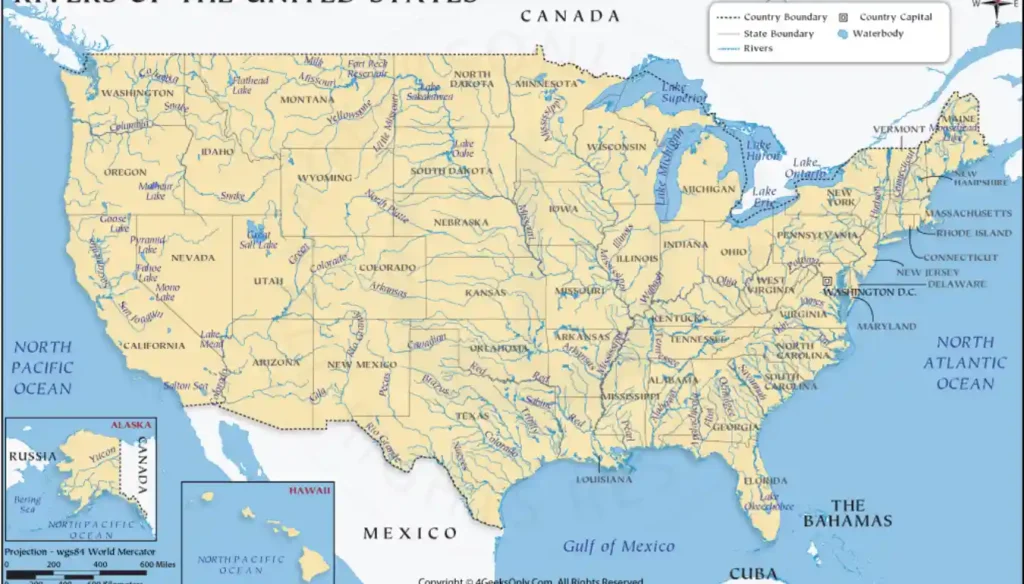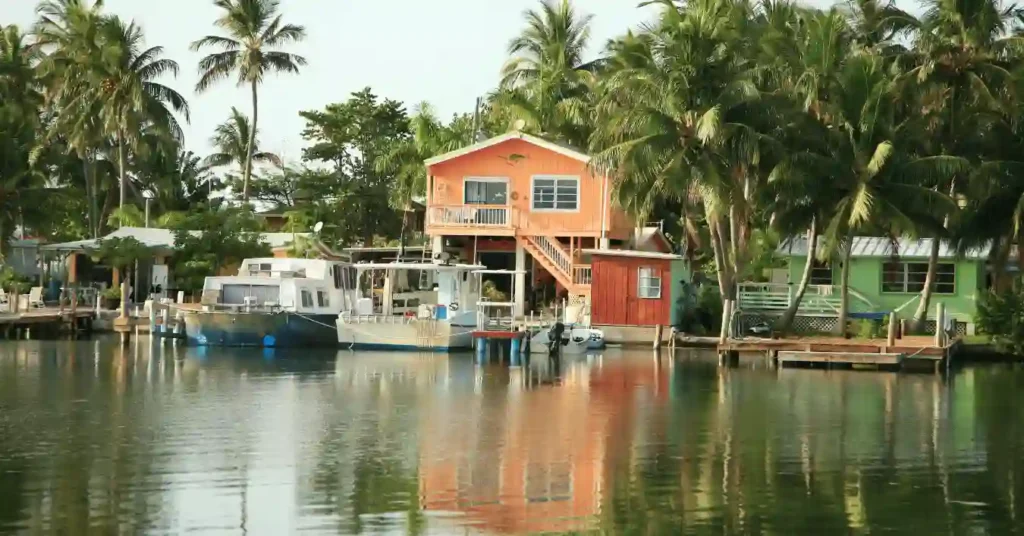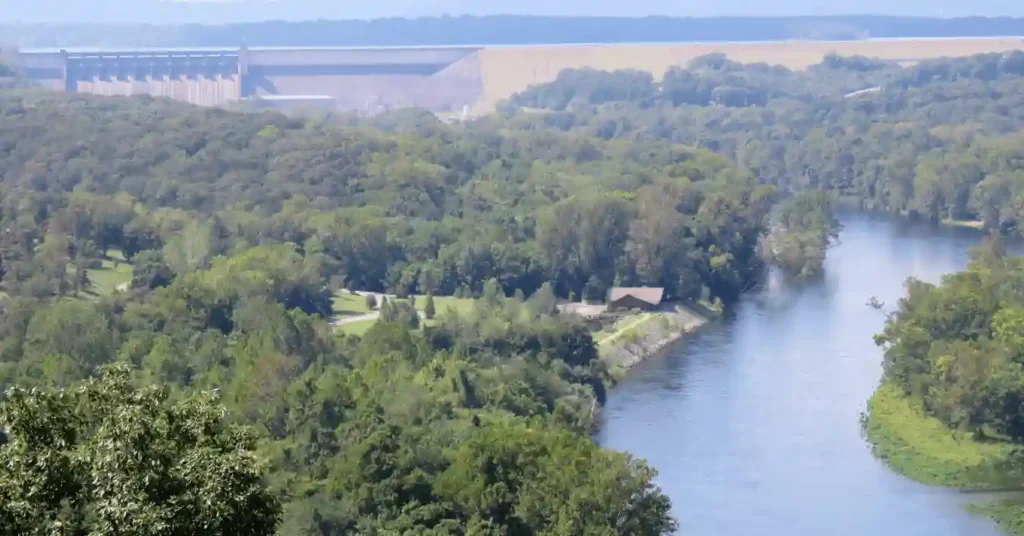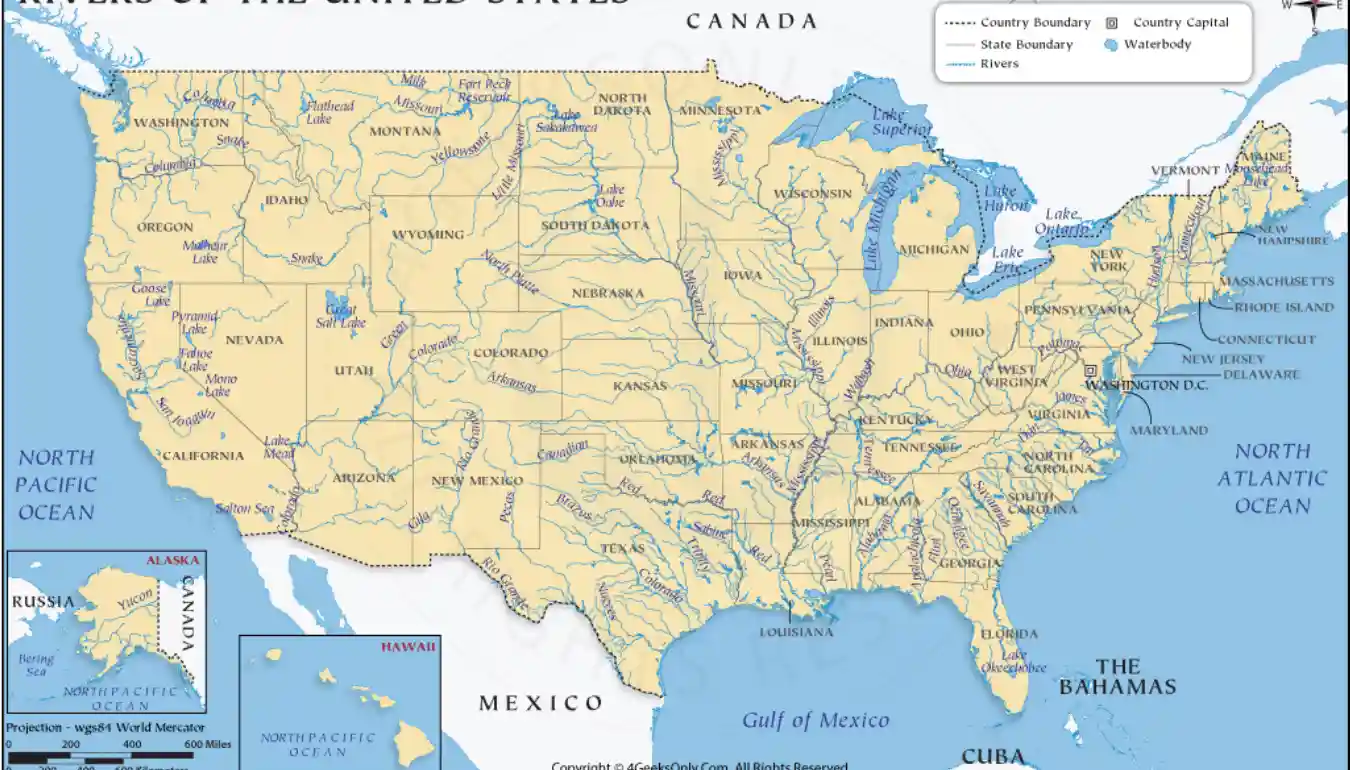11 Best States for Fly Fishing Of USA In 2024

Fly fishing offers endless possibilities. Whether you’re casting along a peaceful trout stream in the early morning or navigating saltwater flats with the hum of the outboard motor, holding your fly rod brings a sense of tranquility. The United States boasts some of the finest fly fishing spots globally, catering to diverse preferences.
From pursuing native brook trout in high mountain streams to tailwater fishing below a dam for sizable brown trout, or even chasing bonefish in the Florida Keys, there’s a dream fly fishing trip waiting for you. Whether you’re planning a getaway to a fishing lodge or seizing a moment during a family vacation to sneak out to the water, the experience is bound to be worthwhile.
No matter your location in the United States, there’s probably fantastic fly fishing just a few hours’ drive from your home. Our nation is teeming with almost endless fishing spots, but unquestionably, some are superior to others. Join us as we explore the top ten states for fly fishing, including two distinctive destinations within each state.
With River Fly’s regional destination guide, you can easily plan an exciting trip, whether it’s just across state lines or across the entire country. Whether you find yourself in the Deep South, the Mountain West, or the Northeast, rest assured that excellent fly fishing opportunities await in your vicinity
In this guide, we will discuss best states in USA and rivers in them.
Best States for Fly Fishing Of USA
1. Florida
Florida stands out as the ultimate saltwater states for fly fishing in the United States. The Keys, with their big and elusive bonefish, wily permit, and abundant tarpon, offer an unparalleled experience. The Everglades add to the excitement with tarpon, redfish, snook, and even largemouth bass. Moving to the Panhandle, you’ll discover tarpon and reds. But Florida’s treasures also extend inland, where largemouth bass thrive in canals, ditches, lakes, and ponds. Even Disney’s lakes boast enormous bass. Florida offers a diverse and thrilling fly fishing experience, whether in its coastal waters or hidden inland gems.
Islamorada

Nestled at the southernmost tip of the U.S. in the Florida Keys, Islamorada isn’t just the best tarpon fishing spot in the country – it’s the best on the entire planet. Year after year, thousands of anglers make a pilgrimage to the six islands comprising Islamorada to engage with what’s hailed as the ultimate fighting fish in the realm of angling.
Due to its global appeal, the town is teeming with fly shops, guides, and every conceivable resource an angler might desire. Whether you’re a seasoned angler or a newcomer, Islamorada promises an unrivaled tarpon fishing experience, making it a must-visit destination for fishing enthusiasts from around the world.
Naples
Situated in Florida, the Naples area is a haven for fly fishers seeking both exciting daytime fishing and luxurious creature comforts at night. Naples enjoys an ideal location, providing swift access to Big Cypress National Preserve, the Everglades, the Ten Thousand Islands, and various other fishing hotspots tailored to your preferences. Whether you opt for the inland lakes for bass and panfish or venture into the saltwater for marlin, sailfish, tuna, and shark, Naples caters to diverse fishing preferences.
Following a rewarding day on the water, indulge in delectable cuisine at one of Naples’s many eateries before retiring to the comfort of your 5-star hotel room. Naples offers the perfect blend of thrilling fishing adventures and upscale relaxation for fly fishers seeking a memorable Florida experience.
2. New York
New York unfolds as a best states for fly fishing haven with a diverse range of opportunities. From Montauk and Long Island Sound to the southern beaches, it’s a paradise for striped bass, bluefish, and false albacore fishing. The Catskills, with rivers like the Beaverkill, Willowemoc, Neversink, and branches of the Delaware, claim the title of the nation’s best trout fishing east of the Rockies. The Adirondacks, steeped in fly fishing lore, add to the state’s charm. New York’s variety includes Great Lakes rivers like the Salmon River, known for salmon and steelhead runs. With such diverse offerings, New York stakes its claim as one of the best fly fishing states.’
Delaware River, New York
Ready for an epic fishing trip in New York? The Delaware River is where it’s happening! With a whopping 75 miles of connected water, it’s a dream for those who want to catch big rainbow trout and other cool fish. This river is like a training ground for fishing enthusiasts – you get to practice your skills in all kinds of water.
Now, here’s a tip: a boat is your best bet in most parts of this river, but there are some spots where you can wade in. If you’re in the northeast and want a great place to fly fish for trout, the Delaware River should be at the top of your list.
3. Montana
Montana is a must-mention in any discussion of top fly fishing states. The Yellowstone, Big Horn, Madison, and Montana portions of Yellowstone National Park rivers are just a glimpse into the plethora of options. From the Beaverhead to the Missouri and various spring creeks, Montana offers an unparalleled trout-fishing experience.
The state’s rivers are teeming with opportunities, solidifying its status as the best trout-fishing state in the union. Also Montana has a long history of fly fishing.
South Fork of the Flathead, Northern Montana
Dreaming of a peaceful fishing spot? Look no further! The South Fork of the Flathead River in Northern Montana is your go-to place. Tucked away in the serene Flathead Valley, it’s like a hidden fishing paradise. The water here is home to some cool native Bull Trout and Cutthroat trout.
These fish thrive in the river, providing an excellent chance to test your fishing skills. But here’s the thing – be sure to check the limited trout fishing season and follow the rules about releasing fish back into the water. So, if you’re up for a bit of adventure in a quiet spot, the South Fork of the Flathead River is calling your name!
Missouri River, Montana
Missouri River in Montana, the fourth largest river globally and a paradise for fly fishing enthusiasts. With over 5,000 fish per mile, this river boasts large trout and carp, making it a haven for fishing aficionados. Starting at Three Forks and flowing gracefully until it meets Canyon Ferry Lake, the Missouri River is renowned for its thick hatches throughout the season, creating an ideal setting for dry fly fishermen.
Here, you can pursue brown and rainbow trout all year round, while carp fishing is especially sought after in the summer. The stretch below the Holter Dam is a famous hotspot on the Missouri River, particularly favored when other rivers are running high from runoff in early June. So, gear up and get ready for an unforgettable fly fishing experience on the majestic Missouri River in Montana!
Kenai River
Enter the legendary Kenai River, a haven for both salmon and trout fishing enthusiasts. Starting your adventure from Cooper’s Landing, where you can find everything from equipment and lodging to fly shops and guided tours, this river provides access to multiple prime spots. Whether you’re targeting monster King (Chinook) salmon on the Upper Kenai, casting for Sockeye at the Kenai/Russian River confluence, or aiming for Rainbow trout and Dolly Varden that feast on salmon eggs, the Kenai River promises big catches no matter where you throw your line. Get ready for an epic fishing journey on the renowned Kenai River!
South Fork of the Flathead, Northern Montana
Dreaming of a peaceful fishing spot? Look no further! The South Fork of the Flathead River in Northern Montana is your go-to place. Tucked away in the serene Flathead Valley, it’s like a hidden fishing paradise. The water here is home to some cool native Bull Trout and Cutthroat trout.
These fish thrive in the river, providing an excellent chance to test your fishing skills. But here’s the thing – be sure to check the limited trout fishing season and follow the rules about releasing fish back into the water. So, if you’re up for a bit of adventure in a quiet spot, the South Fork of the Flathead River is calling your name!
Big Horn River, Montana
Prepare for an angler’s paradise on the Big Horn River in Montana, recognized as one of the finest fly fishing areas in the U.S. The cool and crystal-clear river is home to some of the country’s best wild trout. With an estimated 5-6 thousand rainbow and brown trout per mile, the size of the Brown trout you can reel in is about 15 inches, while the rainbow trout averages around 16 inches.
What makes it even more enticing? The Big Horn River boasts outstanding hatches, making fly fishing enjoyable throughout the entire year – a unique feature compared to other rivers with specific fly fishing seasons. The river caters to both wading and floating, offering a diverse and accessible fishing experience. Get ready for a thrilling adventure on the renowned Big Horn River!
4. Pennsylvania
Pennsylvania, rich in fly fishing history, holds its own among the top fly fishing states. The Letort Spring Run, despite suburbanization’s toll, retains historical significance. Spring-fed creeks around State College, including the Little Juniata, Penn’s Creek, and Spring Creek, offer impressive brown trout populations. Pennsylvania also boasts steelhead and salmon rivers like Elk and Walnut Creek. While lacking a saltwater scene, Pennsylvania’s fly fishing variety and heritage make it a significant player on the angling stage.
Kettle Creek

Pennsylvania unfolds as a prime destination for steelhead and trout fishing, and Kettle Creek takes center stage. This Class-A-rated wild trout water features a cool and fast-rolling stream, hosting abundant annual fly hatches. Wild brown and brook trout inhabit the area, along with large rainbows thriving in these waters.
For the best experience, head to Upper Kettle Creek, known for the highest concentration of wild trout. The lower river may have fewer wild trout, but it offers plenty of browns and rainbows. Patience and the right flies are key to reeling in wild brown trout in this region. Explore the scenic Kettle Creek for a challenging and rewarding fishing expedition!
5. Michigan
Michigan, with its famous Hex hatch, wild Upper Peninsula, and contributions to fly fishing literature, emerges as a notable fly fishing destination. Home to salmon and steelhead from the Great Lakes, Michigan showcases a diverse range of fishing opportunities. The state’s landscape, coupled with its literary connections, adds to the allure of urban fly fishing in Michigan.
Muskegon River
Our list wouldn’t be complete without the mention of the Muskegon River in Michigan, a true gem in the world of fly fishing. Michigan stands out for being home to steelhead and salmon, and the Muskegon River, a tailwater river, is no exception. Flowing from Muskegon Lake to Lake Michigan, it provides a year-round fishery since it avoids freezing in winter.
The Muskegon River boasts a diverse range of fish species, making it a favorite among anglers. With its unique features and abundant fishing opportunities, it solidifies Michigan’s reputation as one of the best fly fishing spots in the country. Immerse yourself in the beauty of the Muskegon River for an unparalleled fishing experiences.
Provo and Weber Rivers
Dive into the unique characteristics of the Provo and Weber Rivers in Utah. Despite sharing origins, these rivers offer different fishing experiences. The Provo River is a year-round haven for top-notch fishing, while the Weber River’s supply depends on farming irrigation along its course. Provo, though popular, can get a bit crowded due to its proximity to towns.
The Weber River, with its inconsistent fish supply, still presents opportunities for fantastic catches. In the upper Weber River, above the Rockport Reservoir, you can target brown, rainbow, and cutthroat trout. Meanwhile, the lower Weber area is home to trophy-worthy brown trout. Explore the diverse offerings of these Utah rivers for an angling adventure like no other!
6. Oregon
While both Oregon and Washington have their merits, Oregon takes the spotlight. Home to rivers like the Clackamas, Deschutes, Klamath, and Umpqua, Oregon offers a rich tapestry for fly fishing enthusiasts. The state’s diverse waters, alongside the influence of notable writers like David James Duncan, make Oregon a top contender in the fly fishing scene.
Deschutes River
The renowned Deschutes River, a popular spawning area offering anglers fantastic opportunities for both trout and salmon. Among the salmon species are Chinook, Coho, and Steelhead. In addition to salmon, anglers can target whitefish and various trout, including the native Rainbow (known as Redsides in Oregon). For the best fishing experience, head to the Lower Deschutes, stretching from Wickiup Reservoir to Benham Falls. Get ready for an exciting angling adventure in this vibrant river ecosystem!
7. Alaska
Alaska, with its short but spectacular fishing season, stands out as a fly fishing paradise. From salmon and steelhead to resident rainbows, grayling, and northern pike, Alaska offers a unique and awe-inspiring angling experience. The state’s wilderness, grizzly bears, and floatplane adventures contribute to the last true American wilderness for fly fishing enthusiasts.
White River

Hey nature lovers! If you’re a fishing fan, you’ve got to check out the awesome White River in Arkansas. It’s famous for its top-notch trout fishing and stretches a massive 720 miles from the beautiful Ozark Mountains to where it meets the powerful Mississippi River. What’s cool about it? The water is super clear, and the temperature is just right for trout fishing all year round.
To catch those big trophy trout, you usually need a drift boat. But here’s a tip: when the dam isn’t releasing too much water, you can find spots along the river where you can wade in. One of the best spots is just below the “Bull Shoals Dam!” People say it’s one of the best places globally to catch those massive Brown trout. So, grab your gear and head to the White River for an amazing fishing adventure!
8. Idaho
Idaho earns its place on the list with a combination of great rivers and challenging trout fishing. The Big Wood, South Fork of the Boise, and Big Lost rivers offer fantastic opportunities. However, what makes Idaho truly special are two places—Silver Creek and the sublime Henry’s Fork of the Snake River. These two rivers are the big leagues, providing some of the most challenging and rewarding trout fishing in the country.
Boise River (South Fork)
For a fantastic fly fishing experience with the comfort of a good night’s sleep, head to the Boise River’s South Fork. Running directly through Boise, this stretch connects anglers to excellent fishing waters and nearby accommodations. Wake up early, explore any of the three forks for Bullhead or Rainbow trout, and then enjoy a delightful dinner in downtown Boise. The waters from Anderson Dam Reservoir to Blacks Creek Bridge are easily accessible and boast abundant trout. Get set for a perfect blend of exciting fishing and cozy accommodations along the South Fork of the Boise River!
Salmon River (Middle Fork)
If you’re looking to escape the beaten path and immerse yourself in the stunning Idaho wilderness, head to the Salmon River’s Middle Fork. While creature comforts may be fewer, many anglers appreciate the rugged charm of the Salmon River. This river offers an abundance of fishable species, including Bull and Rainbow trout, as well as Steelhead and Chinook salmon. Get ready for an adventurous fishing experience surrounded by the natural beauty of the Salmon River!
9. North Carolina
North Carolina, often a surprise on lists like these, offers a remarkable variety of fly-fishing experiences. From mountain trout streams with native brook trout to piedmont reservoirs and farm ponds filled with largemouth bass and bluegills, the state has it all. The Roanoke River’s striped bass run and the coastal areas providing both stripers and redfish add to North Carolina’s diverse offerings.
10. Colorado
Colorado, with over 9,000 miles of trout water, cements its place as a premier fly fishing destination. The Fryingpan, Gunnison, San Juan, Plattes (North and South), and the Colorado Rivers are just a few of the famous options. With such an abundance of trout water, Colorado offers an extensive array of fly fishing experiences, making it a top destination for anglers.
Davis Lake
While our focus has been on trout and salmon, let’s not forget the joy of fly fishing in lakes for panfish like bass. Oregon’s Davis Lake emerges as a top-notch destination, offering some of the finest lake fly fishing west of the Rockies. With Rainbow and Brook trout, Largemouth bass, sunfish, and more, Davis Lake provides an excellent environment to refine your fly fishing skills before embarking on more advanced adventures. Happy fishing at the picturesque Davis Lake!
11. Upper Arkansas
The Upper Arkansas, with its headwaters in Leadville and more than a third of the entire river flowing through the Centennial State, showcasing its strong ties to Colorado. The Upper Arkansas features 102 miles of Gold Medal waters before leaving the state. Here, anglers can try their luck with various trout species, including the Colorado native Cutthroat and Rainbows, all against the backdrop of jagged peaks and expansive blue skies. Get ready to reel in some remarkable catches in this picturesque stretch of the Arkansas River!
Nushagak River

For unparalleled salmon fishing, look no further than the Nushagak River. Hosting Coho, King, Sockeye, Chum, and Pink salmon, this river offers easy access from the riverbanks (once you get there). The months of June and July present the best opportunities for salmon fishing, with over 200,000 King salmon making their run into the state. Fly fishing on the Nushagak begins in the town of Kenai, but for the ultimate spots, you’ll need to take a plane into the bush. Keep in mind that fly fishing on the Nushagak is recommended for experienced fly anglers. Get ready for an adventure in pursuit of salmon on the remarkable Nushagak River!
Roaring Fork
Named for the confluences of the Fryingpan River, Roaring Fork River, and the Colorado River, Roaring Fork offers a diverse fishing experience. Starting at Roaring Fork, anglers can venture to the Gold Medal Fryingpan for Browns and Rainbow trout, stay at the Fork for trophy-sized Browns, or explore down to the Colorado River for an additional 50 miles of Gold Medal waters. The Roaring Fork area is conveniently close to several small towns, providing local fly shops, guides, and other amenities. Get ready to explore the abundant waters and scenic landscapes of Roaring Fork!
Final Words
Ultimately, the distinction of which states boast the finest fly anglers might not hold significant importance. As highlighted earlier, exceptional fly anglers can be found in nearly every state. What truly matters is our commitment to emulate the admirable conduct of the world’s great fly anglers. These individuals exhibit unwavering dedication and passion for the sport of fly fishing, striving to safeguard the waterways in their respective states and preserve them for the enjoyment of future generations.
As fly anglers, we carry the responsibility of passing on our knowledge and skills. Additionally, we must actively address injustices and environmental threats that jeopardize our way of life. By doing so, we contribute to the collective effort to ensure that every state continues to offer outstanding fishing experiences and cultivates a community of exceptional fly anglers.

Meet Ibrahim Khan, an avid angler and author in Fishing Teach. He shares his wealth of knowledge from his 16 years of experiences in fishing. His articles are a captivating blend of practical insights and thrilling tales that invite readers into the enchanting world of fishing.
Ibrahim’s guides are your go-to guide in the realm of fishing on this informational site. Hailing from a coastal paradise, Ibrahim’s passion for angling is the heartbeat of his life.





